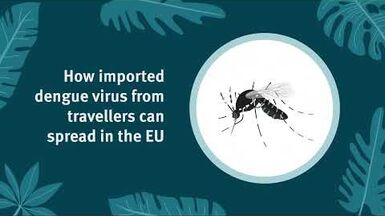An area of controversy – immunising pregnant women against seasonal influenzaArchived
In May 2012 a WHO SAGE (Strategic Advisory Group of Experts) statement on immunisation delivered its opinion on seasonal influenza immunisation through the Weekly Epidemiological Record.(1,2) As already noted in an ECDC Public Health Development (May 25th) this announced a change from the WHO 2005 guidance (3) in declaring a new group, pregnant women, the priority for immunisation above all other groups. It also added young children to the groups that should be offered immunisation, emphasising at the same time the importance of immunising the groups mentioned in the 2005 guidance: older people, all people with chronic conditions, and health care workers with patient contact.
In May 2012 a WHO SAGE (Strategic Advisory Group of Experts) statement on immunisation delivered its opinion on seasonal influenza immunisation through the Weekly Epidemiological Record.(1,2) As already noted in an ECDC Public Health Development (May 25th) this announced a change from the WHO 2005 guidance (3) in declaring a new group, pregnant women, the priority for immunisation above all other groups. It also added young children to the groups that should be offered immunisation, emphasising at the same time the importance of immunising the groups mentioned in the 2005 guidance: older people, all people with chronic conditions, and health care workers with patient contact.
WHO recognised that countries and circumstances vary, and the SAGE also recommended “the prioritization of specific target groups, local implementation timelines and target coverage goals should be determined at regional and country levels, as influenza immunization programmes are dependent on country-specific epidemiology, capacity and resources.”(1) The European Union and EEA countries already have a target of 75% vaccination coverage in older people and those in the clinical risk groups. ECDC has published evidence-based guidance on who to offer immunisation to, (4,5,6) and is now updating its guidance for 2013.
However, the issue of immunising pregnant women is a particularly difficult one. The evidence for and against it was recently summarised by ECDC by using a systematic review and an expert group.(7) Some of the difficulties are reflected in differing results in North America and Europe, and between seasonal influenza and the 2009 pandemic. That is shown in the following two articles.
A large, population-based study of 2009 pandemic influenza A virus subtype H1N1 infection diagnosis during pregnancy and outcomes for mothers and neonates Hansen C, Desai S, Bredfeldt C, et al. J Infect Dis. jis488 first published online August 2, 2012 doi:10.1093/infdis/jis488 This American study, conducted with women registered with health maintenance organisations, identified live births that occurred from 1 July 2008 to 31 May 2010 in five geographically and racially diverse regions. Hence they covered one winter of seasonal influenza (dominated by the old A(H1N1) and B viruses) and another of the 2009 pandemic A(H1N1)pdm09. Pregnant women were considered to have influenza if they had a positive result of a laboratory test, or if they received a diagnosis of influenza during when A(H1N1)pdm09 virus was the predominant circulating virus. The study was large, encompassing 109 015 pregnancies from 107 889 mothers. Among these, 368 pregnant women (0.3%) received a diagnosis of influenza due to seasonal virus and 959 (0.9%) due to A(H1N1)pdm09 virus. A total of 107 688 pregnancies did not receive an influenza diagnosis (the reference group).
The study found that pregnant women with influenza due to A(H1N1)pdm09 virus infection were more likely than women with seasonal influenza infection to be hospitalised within 30 days of the diagnosis (27% versus 12%; odds ratio 2.84 [95% confidence interval {CI}, 2.01–4.02]). Women with seasonal influenza were more likely to be hospitalised than women without influenza though the difference was minor. A difficulty with these studies is whether or not the women were hospitalised because of physician and family concern, especiallyduring the pandemic ,when it was known that there was an association of pandemic influenza and adverse outcomes in pregnant women. To exclude brief precautionary hospitalisations, the authors looked at hospitalisations lasting more than one day. Then they found that the risk of this for women with pandemic influenza was 23%, for seasonal influenza it was 13% and only 7.6% in the reference group. Looking at the occurrence of severe outcomes they discovered that 16 women (1.7%) with A(H1N1)pdm09 developed pneumonia, while only one of the 368 women with seasonal influenza did so. An incidental finding was that women benefitted from early treatment with oseltamivir, as they were less likely to be hospitalised than women who had antivirals late or not at all. The impact on the babies was limited. Among 12 conventional parameter of adverse neonatal outcomes, seasonal influenza was only statistically associated with one, ‘small-for-gestational age’. No adverse neonatal outcomes were significantly associated with maternal A(H1N1)pdm09 infection.
Complications of the 2009 influenza A/H1N1 pandemic in pregnant women in The Netherlands: a national cohort study Bogers H, Boer K, Duvekot JJ.Influenza Other Respi Viruses, 2012 Sep; 6(5):309-12. Epub 2011 Dec 15.This second study, conducted in the Netherlands, looked at national data on the complications observed in pregnant women and due to influenza during the 2009 pandemic . The authors analysed reports to the Dutch national health authority of 69 pregnant or just delivered patients with confirmed influenza A(H1N1)pdm09 infection. Seventeen patients were additionally reported by the contacted hospitals and laboratories. From this total of 86 patients, 59 were eligible and had data available. At admission, the gestational age of six patients (10.2%) was <16 weeks, of 11 patients (18.6%) was between 16 and 28 weeks, and of 40 patients (67.8%) was more than 28 weeks. Two patients were admitted 3 and 7 days after delivery. Median hospital stay was 3 days (range 1–30 days). Fourteen patients (23.7%) had a history of physical co-morbidity, most of them asthma. Forty-three (75.4%) of the women were treated with antiviral medication (all oseltamivir), including six patients that had to be admitted to an ICU for mechanical ventilation. Among the 52 patients not admitted to ICU, no major differences in complications were seen between treated and untreated patients. None of the six patients who were admitted to ICU had a history of co-morbidity. Five were admitted before 37 weeks of gestation (range 30–36 weeks) and all delivered pre-term, and one patient was admitted 3 days post-partum. Three patients (5.2%) were treated with steroids to enhance foetal lung maturation. No ‘small-for-gestational age’ neonates were born, but 11 patients (20.4%) gave birth pre-term. In summary there were no major complications, apart from preterm birth and admission to the neonatal intensive care unit, were observed. There were no maternal or neonatal deaths. The authors considered that the influenza A(H1N1)pdm09 pandemic had a more benign course in pregnant women in The Netherlands compared to North America.
ECDC Comment (25 November 2012):
The main problem for Europe in making policy for immunising pregnant women against seasonal influenza is that while there are some relevant obstetric studies for the pandemic 2009, there are next to none for seasonal influenza.(8,9) Also, the existing studiessuggest a more benign experience in Europe for A(H1N1)pdm09 than in North America. Also the picture with the seasonal influenza pre-2009 is not of a substantial obstetric burden in the USA. Finally, some seasons are needed to observe the ‘new’ inter-pandemic seasonal influenza and see how similar or different it is to the pre-2009 pattern. Despite this uncertainties, the most recent VENICE Influenza Immunisation Survey found there was a majority of EU/EEA countries (19 out of 28) recommending immunisation to all pregnant women, and other three countries reported they offered immunisation to pregnant women with clinical conditions. What is less clear is whether these policies are accepted and acted upon by obstetricians, midwives and pregnant women themselves. What are needed now are large scale observational research like that done in the pandemic (8,9) to see what is the true burden of disease in pregnant women and children from the new seasonal influenza. It will be difficult to conduct conventional trials in Europe to see if there is benefit for the new-born and infant as has been found in poorer communities in north America and Bangladesh, but that may be possible using stepped wedge design.(2,12) Data should be gathered on whether mothers are being offered and are accepting influenza. Finally, as a simple and inexpensive first step, countries could institute reporting of pregnant women hospitalised with influenza.






